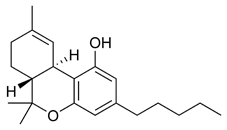Dronabinol
Tetrahydrocannabinol, also known as THC, Δ9-THC, Δ9-tetrahydrocannabinol (delta-9-tetrahydrocannabinol), Δ¹-tetrahydrocannabinol (using an older numbering scheme), or dronabinol, is the main psychoactive substance found in the Cannabis plant. It was isolated by Raphael Mechoulam and Yechiel Gaoni from the Weizmann Institute in Rehovot, Israel in 1964. In pure form it is a glassy solid when cold and becomes viscous and sticky if warmed. more...
THC has a very low solubility in water, but a good solubility in most organic solvents such as pure ethanol or hexane.
Pharmacology
Its pharmacological actions are the result of its binding to the cannabinoid receptor CB1, located in the brain. The presence of these specialized receptors in the brain implied to researchers that endogenous cannabinoids were manufactured by the body, so the search began for a substance normally manufactured in the brain that binds to these receptors, the so-called natural ligand or agonist, leading to the eventual discovery of anandamide and some related compounds. This story resembles the discovery of the endogenous opiates (endorphins, enkephalins, and dynorphin), after the realization that morphine and other opiates bound to specific receptors in the brain.
Effects include: relaxation, euphoria, altered space-time perception, alteration of visual, auditory, and olfactory senses, disorientation, fatigue and appetite stimulation. It also has anti-emetic (anti-nauseant) properties.
Toxicity
THC has a LD50 value of 1270 mg/kg (male rats) and 730 mg/kg (female rats) administered orally dissolved in sesame oil.
If this were scaled up to an adult human, the lethal dose would be between approximately 50 and 86 g for a 68 kg (150 lb) person. This would be equivalent to 1-1.8 kg of marijuana with a 5% THC content (roughly average) taken orally (much more if smoked). It is important to note, however, that toxicity studies in animal models do not necessarily correlate to human toxicity. THC receptor distribution in the rat CNS is different than that of humans, meaning that there is the significant possibility that toxicity in humans varies from the published animal LD50 studies. There has never been a documented fatality from marijuana or THC overdose.
Studies of the distribution of the cannabinoid receptors in the brain explain why THC's toxicity is so low (i.e., the LD50 of the compound is so large): parts of the brain that control vital functions such as respiration do not have many receptors, so they are relatively unaffected even by doses larger than could ever be ingested under any normal conditions.
Research
A number of studies indicate that THC may provide medical benefits for cancer and AIDS patients by increasing appetite and decreasing nausea, and by blocking the spread of some cancer-causing Herpes simplex viruses. It has been shown to assist some glaucoma patients by reducing pressure within the eye, and is used in the form of cannabis by a number of multiple sclerosis patients to relieve the spasms associated with their condition. Government studies indicate a variety of negative effects associated with constant, long-term use, including memory loss, depression and loss of motivation. The long-term effects of THC on humans have been disputed because its status as an illegal drug almost everywhere prevents free research into the subject. The issue has become deeply politicized.
Read more at Wikipedia.org



